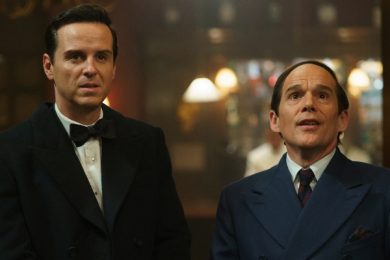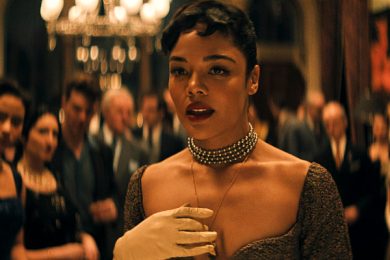If Mad Max: Fury Road felt like so much more than a legacy sequel, that’s because it was. Perhaps it was the abundant trend in the 10’s of rebooting every stitch of franchise IP that made its existence possible, a silver lining amidst a grim Hollywood landscape. But Fury Road was not cooked up by studio heads looking to milk the next piece of nostalgia, but was in fact a project started by the series’ sole director, George Miller, decades before. That there were thirty years (and seven features) in between Miller making Beyond the Thunderdome and Fury Road says less about the franchise’s viability and more about the Australian filmmaker’s taxing eye for detail. If you wonder how the Mad Max films manage to pull off what they pull off, the answer is that they do everything the hard way.
Thankfully, there wasn’t thirty years between Fury Road and Furiosa: A Mad Max Saga, Miller’s latest addition to the series. Furiosa is a prequel, the origin story of the nominal character played iconically by Charlize Theron in Fury Road. Here, she’s played by Anya Taylor-Joy, one of many young actors whose prospects for stardom has crashed on the rocks of the public’s seeming lack of interest in stars. Taylor-Joy’s striking, singular beauty makes her magnetic on the screen, but she’s been cultivating a gift for playing no-nonsense malcontents for the last few years, in films like The Menu and the Netflix series The Queen’s Gambit. Furiosa is a cut above those roles. Physically demanding and emotionally fierce, the 28-year-old actress uses her branded intensity to add more layers to this fascinating character.
Perhaps the worst part about Furiosa is that Taylor-Joy doesn’t even arrive until an hour in. Before that, Miller constructs the character’s lore, detailing her kidnapping at the hands of Dementus (Chris Hemsworth). As a child (played then by Alyla Browne), she lives in the Green Place of Many Mothers, one of the few places in the world not ravaged by global catastrophe. Against the odds, there is still fresh water, green plants, fruits and vegetables. Its imperative that this place be kept a secret from the rest of the world that has fallen into vengeful disrepair, a radioactive landscape of hellacious, gas-powered wrath. Captured by Dementus who wishes to find her abundant home, Furiosa’s mother (Charlee Fraser), chases after her, kills several henchmen, before getting captured herself, and killed right in front of Furiosa.
She becomes mute. Demenus ends up passing her along to Immorten Joe (Lachy Hulme), in exchange for authority over Gastown, the nearby village that holds power over the citadel because of its indispensable resource. Originally groomed as a future wife for Joe, Furiosa manages to disguise herself as a boy and grow up amongst the grease-stained population, planning her eventual escape. An opportunity comes in the form of war rig commander Praetorian Jack (Thom Burke), who takes her on after discovering that she’s secretly hitched a ride through the Wasteland. Jack promises to teach Furiosa everything about driving the rig, and in return, she promises to help him get to the Green Place of her childhood. But reality proves trickier, as Immorten Joe’s war with Dementus ends up entangling them both.
Furiosa takes the long way around, and its first two thirds make thorough work of cementing the motivation behind her journey for vengeance. Broken into five chapters, the first two focus mostly on Hemsworth’s Dementus, a charmingly sick creation that gives the Thor actor a piece of performance unlike any he’s done before. Listening to Hemsworth give interviews for Furiosa might remind many of Robert Downey Jr. last year giving interviews for Oppenheimer, relief that a real auteur gave him the chance to perform something truly daring. Breaking free of the MCU, it’s refreshing to watch Hemsworth lean so far into Miller’s demented world. Funny and eccentric, Dementus is almost charming enough to root for if his sadistic side didn’t unleash a scary amount of homicidal glee.
As fascinating as Hemsworth’s performance is, one does fatigue in the film’s first sixty minutes, as we wait for the real hero of our story to emerge. Once she does, Furiosa kicks into gear (no pun intended), and as she rides into the ferocious Outback desert with Praetorian Jack, Miller constructs several chase sequences of such breathtaking daring and stunning barbarity, that it puts itself on par with the steampunk majesty of Fury Road. Furiosa‘s oil-pumped chase sequences feel more CGI-processed than its predecessor, but Miller’s frenetic pacing (Miller’s films are edited by his wife, Maraget Sixel, though here she shares the credit with Eliot Knapman) gives it a similar unhinged mania; every sequence touched by aberrant details in costuming or production design. One can imagine Furiosa‘s “bobby knocker” gaining similar reputation as Fury Road‘s flame-throwing guitar-shredder.
In Fury Road, part of the excitement was watching Tom Hardy’s Max get surpassed in relevance by Theron’s Furiosa. So I guess it’s poetic that in Furiosa, our title character gets usurped first by Hemsworth’s Dementus and later by Burke’s Jack, two characters who move to push Furiosa in opposing directions of love and hate. This is not a slight on Taylor-Joy, whose performance takes full advantage of her gifts for intensity. Like Max in Fury Road, her collective trauma has turned her almost icomunicable, and she speaks maybe less than twenty lines in the entire film. In the end, this makes Dementus and Jack more compelling characters, more dimensional. Dementus is both grotesque villain and pitiable victim – “hurt people hurt people” taken to its greatest extreme – while Jack is the film’s elliptical leader, a granite showcase of competence and compassion.
I was a bigger fan than most of Miller’s 2022 film Three Thousand Years of Longing, another big budget curio that cared little for its lack of mainstream appeal. There was something very touching about how that film attacked the notion of myth within our everyday lives. There’s a lot of that in Furiosa as well, whether it be in its five-chapter structure or its surprisingly poignant denouement, which suggests some defiance in the face of its own vengeance plot. Longing was perhaps a more appropriate place for this kind of narrative experimentation; in Furiosa it creates a drag which only becomes more pronounced once the movie finally gets going. That said, Furiosa‘s best moments are spectacular, forever nailing that sweet spot between the majestic and the grotesque, and a testament to the power of hope and imagination within a lost world.
Directed by George Miller










